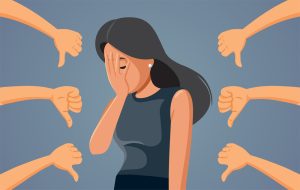I. Introduction
Understanding why some individuals perceive themselves as unlovable is a critical exploration within psychology and social dynamics. This phenomenon often stems from complex interactions among personal experiences, societal expectations, and emotional responses. For instance, schema therapy emphasizes the role of maladaptive schemas and their manifestations in maladaptive behaviors that can reinforce feelings of unworthiness and isolation. Within this framework, schema modes are essential as they reflect varying emotional states that individuals oscillate between, influencing their perception of love and acceptance (Edwards et al., 2017). Moreover, external influences such as familial relationships and cultural narratives significantly shape an individuals sense of self-worth. The portrayal of these dynamics in narratives like the film Precious elucidates how compounded stressors, along with societal neglect, can exacerbate feelings of unlovability, leading to a cycle of despair and disconnection (Chaney et al., 2017). Therefore, diving into the factors that cultivate these beliefs is essential for fostering healthier self-perceptions and interpersonal relationships.
A. Definition of feeling unlovable
The sensation of feeling unlovable is often rooted in complex emotional and psychological dynamics influenced by early experiences and interpersonal relationships. This feeling may be intricately tied to shame, which manifests as negative self-beliefs that individuals internalize, often developed during formative years. Such beliefs can create barriers to intimacy, leading individuals to withdraw from potential connections out of fear of rejection or unworthiness. Psychotherapists frequently observe that shame influences relationship difficulties and can exacerbate mental health issues, underscoring the pervasive nature of these feelings within therapeutic settings (Hulstrand et al., 2015). Moreover, schema therapy highlights the shifting experiential states experienced by individuals, with various schema modes contributing to their sense of self and relational patterns (Edwards et al., 2017). Consequently, understanding the definition of feeling unlovable involves recognizing the interplay between these emotional factors and their impact on an individuals capacity for connection and self-acceptance.
B. Importance of understanding this feeling
Understanding the feeling of being unlovable is crucial because it directly influences emotional well-being and interpersonal relationships. Such feelings often stem from complex emotional dynamics and unconscious defense mechanisms that distort one’s self-perception and understanding of social situations. By analyzing these emotional responses, individuals can uncover the underlying reasons that contribute to feelings of unworthiness, leading to greater self-awareness and personal growth. As articulated in recent philosophical discussions, the dissection of these defense mechanisms can aid in moral inquiry and understanding ones emotional landscape. Furthermore, fostering open dialogue and relationships enhances self-acceptance and compassion, which are vital for overcoming the pervasive sense of unlovability. Engaging in this understanding not only facilitates healing but also promotes healthier connections with others, making it an essential part of navigating human experience (Lacewing et al.), (Milligan et al., 2013).
C. Overview of factors contributing to feelings of unlovability
Feelings of unlovability can stem from a complex interplay of psychological and social factors that shape an individuals self-perception. Central to these feelings is the cognitive triad, which emphasizes negative beliefs about oneself, the world, and the future, often exacerbated by depressive symptoms ((Monnat et al., 2014)). When individuals internalize experiences of rejection or neglect, they may begin to view themselves as unworthy of love, further entrenching these beliefs. Additionally, personal narratives, such as those found in autoethnographic studies, illustrate how significant life events impact emotional development and reinforce feelings of unlovability. The stories shared can reveal underlying patterns of thought and behavior that contribute to self-deprecation ((N/A, 2009)). This combination of cognitive distortions and personal experiences creates a fertile ground for unlovable feelings, often leading to a profound struggle for validation and acceptance from others. Understanding these factors is crucial for addressing the emotions surrounding unlovability.
II. Psychological Factors
Understanding the psychological factors that contribute to feelings of unlovability necessitates an exploration of internalized narratives and schemas formed through early experiences. Individuals often grapple with maladaptive beliefs arising from past traumas or negative societal messages, which can distort their self-image and hinder their ability to foster intimate connections. For instance, Lois-Ann Yamanaka’s exploration of adolescence in Loving the Unlovable Body highlights how these formative experiences shape girls relationships with their bodies and, in turn, their self-worth, revealing a tapestry of emotional struggles that may lead to a sense of unlovability (Baiada et al., 2016). Additionally, cases such as Annas demonstrate how long-standing psychological issues, including post-traumatic stress and avoidant personality disorder, are intricately linked to early traumatic experiences, further illustrating the complexity of unlovability as rooted in deep-seated emotional schemas (Edwards et al., 2014). These psychological elements reflect the profound impact of both personal history and socio-cultural influences on ones self-perception.
A. Impact of childhood experiences on self-worth
Childhood experiences play a crucial role in shaping an individuals sense of self-worth, often laying the groundwork for feelings of unlovability in adulthood. Negative experiences, such as emotional neglect or abuse, can lead to the internalization of harmful beliefs, evidenced by the correlation between adverse childhood experiences and the development of negative core beliefs about the self, specifically unlovability and worthlessness (de Oliveira et al., 2018). These deeply rooted beliefs can manifest as early maladaptive schemas that impact psychological well-being, as observed in individuals suffering from various mental health issues (Stalmeisters et al., 2018). Furthermore, children who encounter consistent criticism or lack emotional support from caregivers may grow into adults who struggle with self-acceptance and maintain distorted perceptions of their worth. This continuous cycle highlights the importance of understanding childhood dynamics, as they ultimately influence how individuals perceive themselves and their capacity to foster loving relationships later in life.
B. Role of mental health issues in shaping self-perception
Mental health issues significantly influence self-perception, contributing to feelings of unlovability and inadequacy. Individuals grappling with conditions such as depression often develop negative schemas about themselves, which can distort their self-image and lead to pervasive feelings of unworthiness. For instance, a study on patients with Myalgic Encephalomyelitis/Chronic Fatigue Syndrome (ME/CFS) found that early maladaptive schemas (EMS) negatively affected their psychological well-being, suggesting that these ingrained beliefs can shape one’s self-concept and overall quality of life (Stalmeisters et al., 2018). Furthermore, societal norms around masculinity exacerbate these issues, particularly among men who conform to restrictive emotional norms. Research indicates that men adhering to such norms are less likely to seek help, resulting in a higher risk for suicidal thoughts and behaviors, illustrating how mental health struggles can entrench feelings of unlovability and isolation (Eggenberger et al., 2024). This interplay underscores the critical need for addressing mental health to reshape self-perception positively.
C. Influence of negative self-talk and cognitive distortions
The pervasive influence of negative self-talk and cognitive distortions significantly contributes to feelings of unlovability, often perpetuating a cycle of self-doubt and emotional distress. Individuals who engage in negative self-talk frequently distort their perceptions of reality by filtering experiences through a lens of inadequacy, leading them to believe they are undeserving of love and connection. Cognitive distortions, such as catastrophizing or all-or-nothing thinking, exacerbate these feelings by reinforcing an internal dialogue that is harsh and unforgiving. For instance, when individuals interpret setbacks as definitive failures, they may develop a diminished sense of self-worth, impacting their interpersonal relationships and self-image. This unhealthy mindset not only affects how they perceive themselves but also how they interact with others, as they may subconsciously push away those who could provide affirmation and support. Understanding this complex interplay is crucial in addressing the roots of unlovability, as explored in various studies, including insights drawn from related research on familial relationships (Fox S, 2023) and voluntary reunification processes (Matthewson M et al., 2023).
III. Social Influences
Social influences play a pivotal role in shaping individuals perceptions of loveability, particularly in how societal norms and interpersonal relationships inform self-esteem and emotional health. For instance, individuals often internalize the messages conveyed by social media, peer groups, and familial expectations, leading to feelings of inadequacy and unlovability if they do not conform to these ideals. The misdiagnosis of mental health conditions, particularly among autistic individuals, exemplifies how societal misunderstandings can exacerbate feelings of being unworthy of love and support. Autistic persons frequently report that healthcare professionals confuse their autism characteristics with other mental health issues, leaving them feeling misunderstood and isolated (Sheena K Au‐Yeung et al., 2018). Furthermore, advancements in mental health interventions, such as the development of clinical LLMs, hold promise for enhancing individual support and addressing these social barriers, yet they must be carefully implemented to ensure they align with effective therapeutic practices (Stade EC et al., 2024).
A. Effects of societal standards and expectations on self-image
The pervasive influence of societal standards and expectations significantly impacts self-image, often leading individuals to feel unlovable. Media portrayals, cultural norms, and peer comparisons continually shape our perceptions of beauty and worth, creating a landscape where many feel they fall short. This phenomenon is especially troubling among diverse demographics; for instance, women, regardless of their age or racial background, actively engage in self-monitoring their bodies in response to external pressures. Research shows that both Caucasian and African-American women utilize various strategies, including diet and cosmetic enhancements, to conform to these ideals, highlighting a collective vulnerability to body dissatisfaction and related psychological issues (Gill et al., 2008). Meanwhile, children and adolescents also navigate these expectations, which can trigger profound mental health challenges such as anxiety and depression (LaBrie et al., 2025). Ultimately, the relentless pursuit of societal approval undermines self-esteem and fosters feelings of inadequacy, contributing to the sense of unlovability.
B. The role of relationships and social connections in feelings of unlovability
The intertwined nature of relationships and feelings of unlovability offers critical insights into connection and isolation in human life. It’s generally the case that people who see themselves as unlovable frequently struggle with negative self-perceptions arising from less-than-ideal social interactions. As (Kurle et al., 2023) points out, feelings of inadequacy and unworthiness may intensify sensations of disconnection; this creates a self-reinforcing pattern that distances individuals from potential support systems. Moreover, societal norms and gender roles, as seen in Margaret Laurence’s work, can distort relationships and reinforce feelings of inadequacy; societal expectations can really complicate things. Laurence’s stories show relationships marked by discord, reflecting how outside pressures can hinder personal fulfillment and encourage feelings of being unworthy of love. Thus, inadequate social connections not only keep unlovability going but also reduce chances to develop meaningful relationships that push back against these feelings.
C. Impact of social media on self-esteem and comparison
Social media’s reach is wide, and it has cultivated a culture of comparison that really hits at a person’s self-worth. People often see carefully chosen pictures and seemingly perfect lives, which makes them feel like they don’t measure up. This constant stream of images can make someone think their worth depends on what others think, and that can lead to feeling truly unlovable. Research shows that trying to fit in, especially on social media, can lead to problems like depression and even thoughts of suicide; the impacts go beyond just surface-level self-image and can affect overall mental health, especially for men who might feel pressured to act a certain way (Eggenberger et al., 2024). Engaging in social comparison could also make it harder to form close relationships, which are so important for support and forgiveness, possibly leading to greater anxiety and avoidant attachment styles (Krajewski et al., 2004).
IV. Cultural Perspectives
Cultural viewpoints can really shape how people feel about being unlovable, mainly because they affect how we see our own value and relationships in different communities. For instance, in cultures that value group harmony, your self-worth might depend heavily on whether your family or community approves of you. When people can’t meet those group expectations, it can make them feel even more inadequate. We can see this cultural influence more clearly by looking at biographical interviews, where stories told in group settings show how our personal feelings and reactions are connected to cultural stories about fitting in (Harding J). Shame, while felt everywhere, is also understood differently across cultures and can really impact our mental health. It usually stems from what we deeply believe about our own value, causing us to react defensively and making it harder to connect with others. When therapists deal with these issues, acknowledging how important relationships are can help people work through feelings of shame and develop a healthier sense of themselves (Hulstrand et al., 2015).
A. Variations in expressions of love and acceptance across cultures
The ways we show love and acceptance? They’re not the same everywhere you go, and that really colors how people feel about whether they’re worthy of love in the first place. Take cultures that are big on “we” instead of “me.” They might show love through strong family bonds, putting loyalty to the group ahead of, say, a grand romantic gesture. On the flip side, more individualistic places might treat personal success as a form of self-love – but that can backfire, leaving people feeling unlovable if they *aren’t* racking up achievements. Now, it’s interesting: People who don’t have a huge need to fit in seem to be hit especially hard when society’s idea of love shifts, especially those with a fearful attachment style (Ford et al., 2018). If these folks feel rejected, they’re more likely to see every little thing as a sign that they’re just plain unlovable (Ford et al., 2017). So, when you get right down to it, understanding that love looks different depending on where you are can shed light on why some people wrestle with these feelings of unlovability – it’s all tangled up with what society expects and how you see yourself.
B. Cultural stigmas surrounding vulnerability and emotional expression
Cultural stigmas—those attached to vulnerability and emotional expression—really play a big part in how people can feel unlovable, you know? It’s like, societal norms often push this idea of being stoic, especially for men. Showing your emotions? That’s seen as weakness. This kind of story our culture tells makes it harder for people to reach out when they’re struggling. They end up feeling isolated and ashamed. For example, it’s been shown that women dealing with alcohol dependence often feel a deep sense of shame because of what society expects from them, and (R J Lamb et al., 2024) that just makes getting better even harder. Think about northern British Columbia, too. The silence around mental health and suicide there just shows how much culture can mess with how people see help and support. In (Usipuik M, 2024), the people involved really talked about wanting connection and how much the stigma in society hurt them. It shows how important it is to create spaces where emotions are okay and where people can really connect.
C. Influence of cultural narratives on individual self-worth
Cultural stories are pretty important; they really help shape how we feel about ourselves, especially when it comes to who we think we are and where we fit in. You see these stories everywhere—in books, on TV, and just how people act around each other. Sometimes they back up what we already think about our worth, but other times they shake things up. Take, for example, the tough histories of oppression. Toni Morrison dives deep into this, showing how those experiences can mess with how people see themselves, particularly in groups that have been pushed to the side. Her characters often face awful choices because of what theyve been through racially. It shows you just how much these cultural stories can affect whether they feel like they have any control over their lives and how much they value themselves (Yasin et al., 2011). Then, when you look at how people figure out who they are—like Ralph John Rabies work—it gets even more interesting. He looks at different parts of a persons personality to see how they deal with problems on the inside that come from what society expects and the cultural stories we all hear. This can really change how someone feels about themselves and whether they think they belong (Uys et al., 2010). Its all connected, really: these cultural stories and how we value ourselves. It just goes to show how important context is in understanding the human experience.
V. Conclusion
To summarize, those feelings of not being lovable that people have often come from really deep psychological stuff, usually going back to family stuff from when they were kids. Dysfunctional families can really mess you up, causing feelings like hopelessness, guilt, and just a general feeling of not being good enough; studies of adults who grew up in these kinds of families show that they often struggle with the idea that they are simply unlovable (Andhika et al., 2021). Then, when tough stuff happens in life, like loss or being abandoned, these feelings can get even worse, making people feel lost and disconnected from others (Ciarrochi et al., 2022). So, dealing with these deeply held beliefs requires a few things, like getting to know yourself better, making real connections with people, and understanding how your past affects how you feel now. With that understanding, people can start to feel worthy again and find more love and acceptance, generally speaking.
A. Summary of key points discussed
Several key aspects come to light when unraveling the intricate web of why someone might feel unlovable, highlighting how personal experiences and society intertwine. Interpersonal relationships, particularly in one’s early years, have a big impact, really shaping how we see ourselves. People often internalize negative comments or a lack of attention, and this can lead to a long-lasting feeling of being worthless, like they don’t deserve love. Moreover, society’s expectations and cultural norms add to these feelings; unrealistic worth standards can make people who don’t fit in feel even more alienated. As one study on biographical interviews points out, different methods can draw out different personal stories, emphasizing the emotional aspects of talking about personal experiences. These biographical narratives, collaborative in nature, allow for both personal and collective thought, really driving home the subjective complexities that can make someone feel unlovable (Harding J), (Vassiljeva et al., 2018).
B. Importance of addressing feelings of unlovability
Dealing with feelings of being unlovable stands as a key factor in supporting both emotional health and the way we relate to each other. Quite often, people struggling with these feelings start to internalize shame. This shame makes it harder for them to bond with others, which only makes them feel more alone. If someone feels unlovable, they might pull away from relationships, which unfortunately just keeps the cycle of loneliness going and makes them feel even worse. As noted in (Lancaster et al., 2011), recognizing this pattern is essential for tackling that internalized shame, with the goal of improving how connected someone feels and building their confidence. What’s more, recognizing a person’s religious views and spiritual beliefs can be a source of real support during therapy, because these factors play a role in how they see themselves and deal with those feelings of unlovability (Ekşi et al., 2020). By addressing these different emotional and mental aspects, therapeutic approaches can help build self-acceptance and encourage healthier, more satisfying relationships, challenging those incorrect beliefs that feed into feelings of being unlovable.
C. Suggestions for fostering self-acceptance and love
Dealing with feelings of being unlovable really hinges on building self-acceptance and, well, self-love. These feelings often bubble up from negative views we’ve absorbed from society’s expectations. Now, one way to boost self-acceptance is through cognitive behavioral therapy, or CBT. It’s all about getting to grips with and changing those negative thought patterns (Kazantzis N et al., 2024). Plus, mindfulness can be pretty life-changing. It lets you watch your thoughts and feelings without jumping to conclusions, helping you see your own value without being too critical (Axelrad et al., 2018). It’s also key to practice some self-compassion – be kind to yourself when things go wrong or you feel you’re not up to scratch, understanding that being imperfect is just part of being human. And don’t forget the importance of good friends; having strong social connections gives you a chance to feel valued and have your self-worth reinforced. Overall, these kinds of approaches can do a lot to increase how much you accept yourself, leading to a stronger sense of self-love.
Additional Blogs
People Pleasing Blog: Click here
Additional Resources
Geher, G. (2022). “The Psychology of Feeling Unloved”. Psychology Today. Access here
Ethans, L. (2023). “5 Traumas That Make Someone Feel Unlovable”. Power of Positivity. Access here
“Feeling Unlovable: Overcoming the Internal Struggle”. Psychology. Access here
“Am I Unlovable? Discovering the Truth About Your Self-Worth”. Psychologily. Access here








































